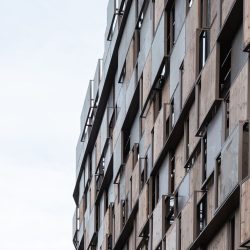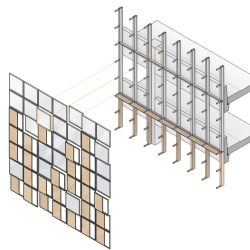
Vilhelm Lauritzen Architects . photos: © Sjavit Maestro
The Timber House is a parking garage that intends to show how a simple typology as parking can become a work of art. Thus, it is designed to add value beyond its functional purpose and elevate the urban environment around it, offering a visual and engaging architectural addition to the area.
The building is 13,300 m2, six storeys and holds the space of 430 cars. It is erected in Copenhagen’s new area Nordhavn – an area of approximately 2 km2 and historically a part of Copenhagen’s 19th century industrial Freeport. The location is an area where timber was shipped, stored, and handled, hence its Danish name ‘Trælasthuset’ (translates as a house where timber is loaded)
The three-dimensional pixelated façade of wood and recycled aluminum is designed to interact with light. It references a timber stack as it appears at a sawmill. Here, individual beams never lie exactly on top of each other, and these small displacements inspired the idea of shifting the pixels to generate relief. This expression is an homage to the area’s history as a place that stored and handled timber.
The basis of the façade structure is a lightweight and luminous recycled aluminium frame, augmented with perforated plates. Each pixel is either at the very front of the façade or 30 centimeters retracted to create an effective three-dimensional relief that captures both daylight and the interior artificial light. The heft of the base is generated through the implementation of expanded wood façade panels, arranged in a patterned formation, and mounted onto a framework of hardwood slats affixed directly onto the raw concrete structure.
External lighting is composed of vertical linear luminaires that support the curved and repetitive façade rhythms. This creates a varied and atmospheric play of light, particularly in the edge zone, where light is integrated into both benches and paving. This highlights and reinforces the architectural features in the landscape surrounding the parking garage. Inside, the motion-controlled LED lighting ensures a well-lit building where the light simultaneously shines through the perforated façade and generates a poetic, sensuous feel to its context.
The common thread is the integration of green infrastructure, such as the lush green wall, green rooftop elements and rooftop solar panels demonstrating a commitment to sustainable design elements, yet also rethinking the use of intricate structural design.
The Timber House encourages drivers to park and use the neighboring metro station to and from the city center or explore the area on foot. In addition to parking spaces, it is multifunctional and designed with a vibrant, green outer perimeter, (coming) shops and meeting places as well as a Kiss-n-Ride function.
The Timber House was an open competition where the client sought a symbiotic relationship between parking, urban context, and the city’s functional program. The brief was a façade that has a sculptural depth and meticulously evokes a sensory allure. The significance of lighting was paramount, with careful consideration given to cultivating an evocative and mood-setting atmosphere while ensuring a safe urban district.
_



























